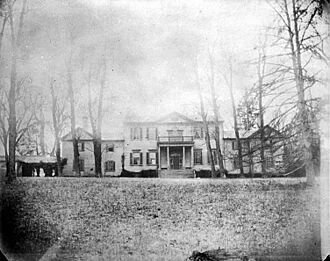Ravensworth (plantation) facts for kids
Quick facts for kids Ravensworth |
|
|---|---|
 |
|
| General information | |
| Location | Annandale in Fairfax County, Virginia, U.S. |
| Country | U.S |
| Coordinates | 38°48′32″N 77°13′23″W / 38.809°N 77.223°W |
| Completed | 1796 |
| Demolished | 1926 |
Ravensworth was a large, old house built in 1796 near Annandale, Virginia. It was home to several important families, including the Fitzhugh and Custis families. Many famous people lived there over the years.
Contents
Where Was Ravensworth Located?
Ravensworth was in Fairfax County, Virginia, close to Annandale, Virginia. It was south of Braddock Road and west of the Capital Beltway. Today, this area is a neighborhood.
The History of Ravensworth Estate
Ravensworth was one of three big houses built on a huge piece of land called the Ravensworth land grant. The other two houses were Ossian Hall and Oak Hill.
The Fitzhugh Family Home
The first owner of Ravensworth was William Fitzhugh. He owned a lot of land in northern Virginia. He was also an important leader who helped create the United States. He was part of the Continental Congress and Virginia's state government. William Fitzhugh passed away in 1809 and was buried at Ravensworth.
His family also owned a house in Alexandria. In 1818, they lent it to their cousin, Anne Hill Carter Lee. She was the mother of Robert E. Lee, who would later become a famous general. Anne Hill Carter Lee later died at Ravensworth in 1829.
After William Fitzhugh, his son William Henry Fitzhugh owned Ravensworth. He died in 1830. His wife, Anna Maria Sarah Goldsborough Fitzhugh, managed the estate until she died in 1874. They did not have children.
Connections to Famous Families
William Fitzhugh's daughter, Mary Lee Fitzhugh Custis, married George Washington Parke Custis. He was the grandson of Martha Washington, America's first First Lady. Mary Lee Fitzhugh Custis became the main lady of Arlington House.
Her grandson, William Henry Fitzhugh Lee, inherited Ravensworth in 1874. He was a general for the Southern states during the Civil War. He lived at Ravensworth until he died in 1891. Later, in 1897, his brother George Washington Custis Lee moved to Ravensworth. He had been the president of Washington and Lee University. He lived there until he died in 1913.
Ravensworth During the Civil War
When the Civil War began in May 1861, Mary Anna Custis Lee (Robert E. Lee's wife) left Arlington House. She stayed at Ravensworth for a short time. However, she soon moved further south. She was worried that the house might get damaged during the war.
Both the Union (Northern) and Confederate (Southern) armies used the Ravensworth area. They found supplies and used its good location. In 1863, Union soldiers collected hay there. A group of Confederate soldiers, led by John S. Mosby, even slept in a haystack at Ravensworth one night. When they woke up, they realized they were very close to a Union army camp! Luckily, both armies had orders not to harm the three big houses on the Ravensworth land.
The End of Ravensworth
Sadly, the Ravensworth house burned down in a mysterious fire on August 1, 1926.
In 1957, the land was sold to be developed into new homes. The remains of the Fitzhugh family, including William Fitzhugh, were moved. They were reburied at Pohick Church in Lorton. The land where Ravensworth once stood is now a neighborhood called Ravensworth Farm. Today, the area is also known as Ravensworth. In 2010, about 2,466 people lived there.
See also
- Historic houses in Virginia


